Semester 1, 2005 |  RSS (Subscribe) RSS (Subscribe) |
6th June 2005: An unexpected ultraviolet light show
While performing a routine survey of galaxies at ultraviolet wavelengths NASA's Galaxy Evolution Explorer caught the nearby star GJ 3685A erupting into a massive ultraviolet flare. The flare nearly overloaded the telescope's detector as it brightened by a factor of at least 10,000.GJ 3685A is a small red dwarf about 46 light years from Earth. Flares, such as the one observed, are huge releases of energy from a single location on the star's surface and tend to occur both frequently and violently on red dwarfs. Preliminary analysis of this recent flare suggests that the mechanisms that drive these eruptions may be more complex than previously thought.
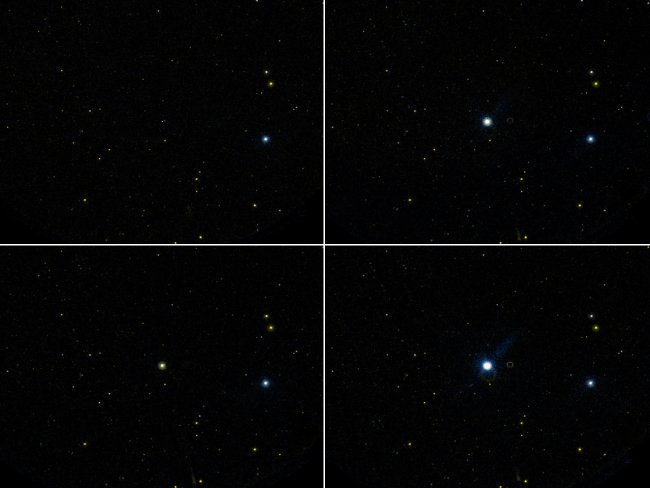
NASA's Galaxy Evolution Explorer catches an ultraviolet flare on the star GJ 3685A.
Image Credit: NASA/JPL-Caltech
30th May 2005: Andromeda galaxy bigger than originally thought
It seems that astronomers have underestimated our nearest galactic neighbour M31 - it is three times larger than previously thought! Astronomers from the US and France were mapping out the motion of stars in M31 (the Andromeda galaxy) when they discovered that stars previously thought to be part of the halo were in fact part of its disk. The discovery hadn't been made earlier because very precise observations of these stars were required to detect their motion. The new results suggest that M31 is now over 220,000 light-years in diameter.The researchers have also found that the outer clumpy regions of the disk are as a result of smaller satellite galaxies slamming together a long time ago to form the galaxy we see today.

M31 - The Andromeda Galaxy taken with the Isaac Newton Telescope
Image Credit: IAC/RGO/Malin
23rd May 2005: Energetic cosmic partices produce unusual radio flash
Using a new prototype radio telescope (LOPES), a group of astrophysicists have been able to record the brightest and fastest radio blasts ever seen on the sky. These blasts occur when ultra-high energy cosmic ray particles hit the Earth's atmosphere. Although they last only for 20-30 nanoseconds they appear more than 1000 times brighter than the sun.LOPES is a prototype of the high-tech LOFAR (LOw Frequency ARray) radio telescope that uses a radical new design allowing it to see the entire sky over a broad range of radio frequencies simultaneously. The experiment has so far shown that the radio emission varies in strength relative to the orientation of the Earths magnetic field - this is as predicted by theory. However, the source of the particles causing the radio emission still remains a mystery. It is hoped that further investigations with LOPES and its succesor LOFAR may shed some light on this problem.
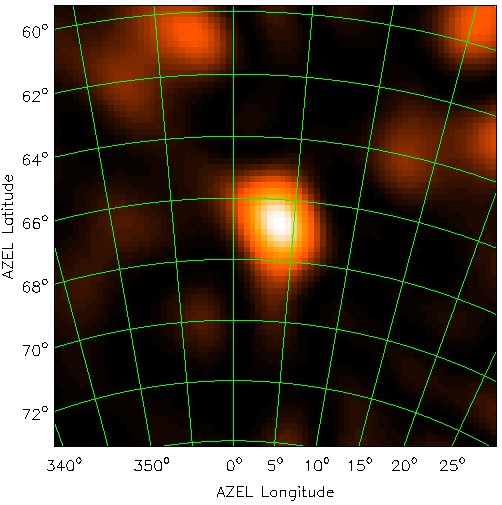
LOPES low-frequency radio image of a radio flash occuring at the same time as a cosmic ray hit.
Image Credit: LOPES Collaboration
16th May 2005: X-ray super-flares help "Solar System" formation
By focussing NASA's Chandra X-ray Observatory on the Orion Nebula for almost 13 days scientists were able to obtain the deepest ever X-ray observation of a star cluster. The results found that young solar-like stars erupt in huge flares that dwarf anything seen from the Sun today. Interestingly enough these X-ray flares may actually help the survival of Earth-like planets in planetary systems forming around these stars. Recent theoretical studies suggest that X-ray flares can create additional turbulence when they hit a planet-forming disk. More specifically this can affect the position of the newly forming rocky planets and can help prevent them migrating towards the young star. Without the X-ray flares rocky planets may end up too close to the young star or may even plummet into the star itself.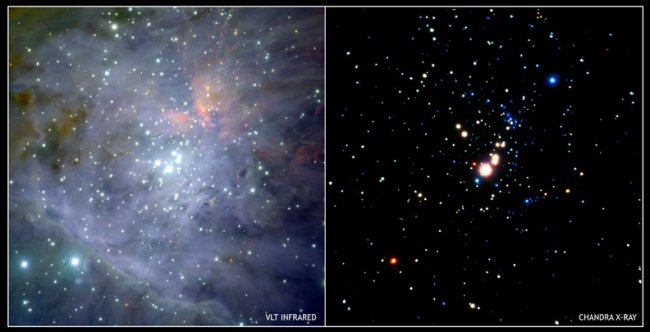
VLT infrared image of the orion nebula (left) and Chandra X-ray image (right).
Image Credit: ESO/VLT/M.McCaughrean et al.
9th May, 2005: Phoebe a long way from home
New information on Phoebe ("FEE bee"), one of Saturn's outermost moons, confirms the belief that it did not actually form at Saturn. The Cassini probe flew past Phoebe on June 11th 2004, the data collected at the time helped astronomers make an accurate estimate of its density. It turns out that Phoebe has a density of about 1.6 grams per cubic centimetre which is much lighter than most rocks but 70% heavier than pure ice, that is, it is composed of a mixture of rock and ice. This composition is similar to that of objects in the Kuiper Belt and that of Pluto and Neptune's moon Triton. Phoebe also has a retrograde, highly eccentric and highly inclined orbit. These clues all suggest that Phoebe was captured by the gravitational field of Saturn after being perturbed from its birth place somewhere in the Kuiper Belt.
Cassini image of Saturn's moon Phoebe.
Image Credit: NASA/JPL/Space Science Institute
2nd May, 2005: Spitzer takes image of the Sombrero galaxy
The Spitzer Space Telescope recently took this image of M104 - more commonly known as the Sombrero Galaxy because of its uncanny similarity to the Mexican hat by the same name. A spectacular image of M104 was previous imaged by the Hubble Space Telescope in visible light, the Spitzer image however shows a view of the galaxy through infrared eyes. Infrared views trace the dust within the galaxy and makes the dark ring of the optical view glow brilliantly. Infrared views also allow for "deeper" views because the dust in the galaxy effectively becomes transparent - thus providing a clear view of the inner disk within the dust ring.
Spitzer image of the Sombrero Galaxy.
Image Credit: NASA/JPL-Caltech/R. Kennicutt (University of Arizona) and the SINGS team
25th April, 2005: The Cosmic Whirlpool
The Hubble Space Telescope (HST) took this sharpest-ever image of M51 in January. More commonly known as the whirlpool galaxy, M51 is a classic spiral galaxy with its two prominent spiral arms that contain highly active star formation regions. It is believed that NGC 5195, the small yellow galaxy lurking in the background, helps to maintain the frenetic rate of star formation in M51s spiral arms through its gravitational influence. As NGC 5195 passes behind M51 it generates waves within M51s flat disk. As these waves pass through gas clouds in the disk they compress the gas along the inner edge of the arms initiating a subsequent collapse of the gas cloud and resulting in star birth. The dark dusty parts of the galaxy are regions of dense gas clouds whereas the bright pink parts are the star forming regions. As the stellar winds and supernovae blow off obscuring gas they reveal bright blue star clusters throughout the spiral arms.
Hubble Space Telescope image of M51.
Image Credit: S. Beckwith (STScI) Hubble Heritage Team, (STScI/AURA), ESA, NASA
18th April, 2005: Spitzer Observes Bursting Bubble
The Spitzer Space Telescope took the image below of RCW 79. This bubble of gas and dust is about 70 light years in diameter and over 17,000 light years from Earth. The bubble is being blown out by the radiation and winds of hot young stars which form as the bubble expands into the interstellar gas and dust that surrounds it. Throughout its million-year long expansion RCW 79 has helped to give birth to at least two groups of news stars as seen along the edge of the large bubble. Some are also visible inside the small bubble (lower left section of the large bubble).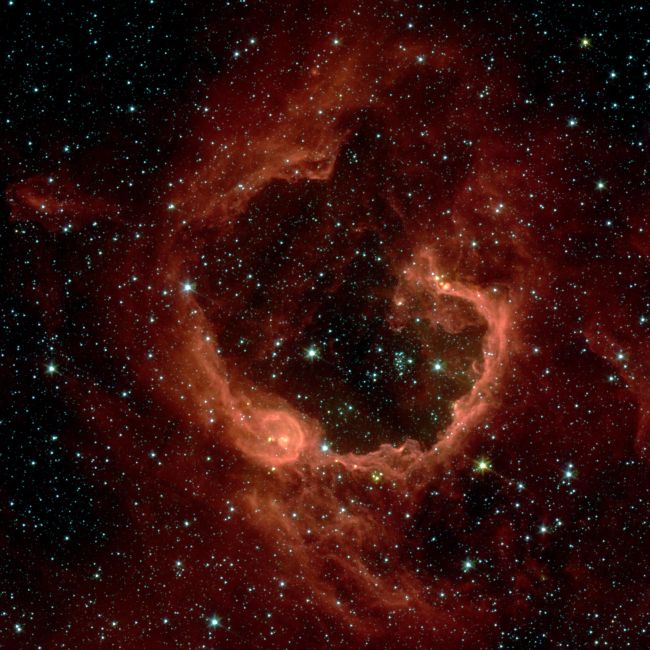
Spitzer Space Telescope image of RCW 79.
Image Credit: NASA/JPL-Caltech/E. Churchwell (University of Wisconsin-Madison)
On the doom and gloom side of things it seems that the 300m wide asteroid (2004 MN4) that was supposed to just miss the Earth in 2029 may actually come in for an even closer look in 2034 and 2035. Although 2004 MN4 will miss the Earth by 24,000 to 40,000 km in 2029, such a close flyby makes it very difficult to predict how the Earth will affect its orbit during the close encounter. It is possible that its orbit may be deflected enough to cause a collision with the Earth during its next close flyby in 2034 and 2035 with a force equivalent to about 10 Krakatoa-size volcano explosions or 40,000 Hiroshima-size bombs. But don't let this stop you from finishing your SAO projects - NASA has only given it a Torino Scale rating of 1 and the current odds of a hit are 15,000 to 1 (the original 2029 flyby of 2004 MN4 had 1 in 38 chance of a hit until further observations and simulations showed that it would in fact miss).
11th April, 2005: Shuttle, Probes and Rovers
Whilst Cassini, XMM-Newton, Chandra, SOHO, Spitzer, Mars Express and Swift findings continue to tell us more about life, the Universe and everything, the big news for the week is the arrival of NASA's Space Shuttle Discovery at the launch pad in preparation for a mid-May blast-off. Discovery will be the first shuttle to be launched since the tragic re-entry of Space Shuttle Columbia over two years ago.Rovers are also talk of the month with the European Space Agency (ESA) making strong recommendations to send a rover to Mars by 2013 and a sample-return mission around 2016. Meanwhile, NASA has also given the nod for Mars Exploration Rover's Spirit and Opportunity to continue their marathon exploration of the Martian surface for up to a further 18 months. On the downside, cost-cutting at NASA may finally put an end to the incredible 28 year journey of the twin Voyager probes - just as they on the verge of being the first probes to reach the edge of our solar system.
President George W. Bush's proposal to send astronauts to the moon and Mars seems to have spurred on a great deal of interest in the moon. Japan has recently unveiled plans to send humans to the moon by 2025. Whilst India and ESA have approved a cooperative project to launch the Chandrayaan-1 probe to the Moon in 2007/2008. Meanwhile, ESA's lunar probe SMART-1 has had its mission extended till August 2006.
Finally, although suffering from a slight case of blurred vision, NASA's Deep Impact probe is looking good for its encounter with Comet Tempel 1 on July 4th.
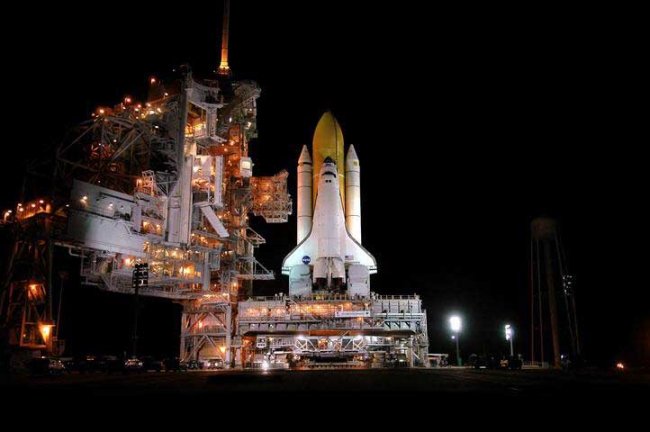
NASA's Space Shuttle Discovery at the launch pad.
Image Credit: NASA
4th April, 2005: Hubble Space Telescope reveals galaxy merger remains
NGC 1316 is a giant elliptical galaxy approximately 75 million light-years away that resides in the outskirts of the Fornax galaxy cluster. Also known as Fornax A, it is one of the strongest radio sources in the sky with radio lobes extending over several degrees. The image below reveals dust lanes and patches that are believed to be the remains of the interstellar medium associated with one or more of the spiral galaxies that merged with NGC 1316. Using the Advanced Camera for Surveys (ACS) instrument on the Hubble Space Telescope astronomers were able to study its globular clusters. By counting them as a function of their brightness they could see evidence of a gradual disruption in star clusters created during a past merger with a gas-rich galaxy.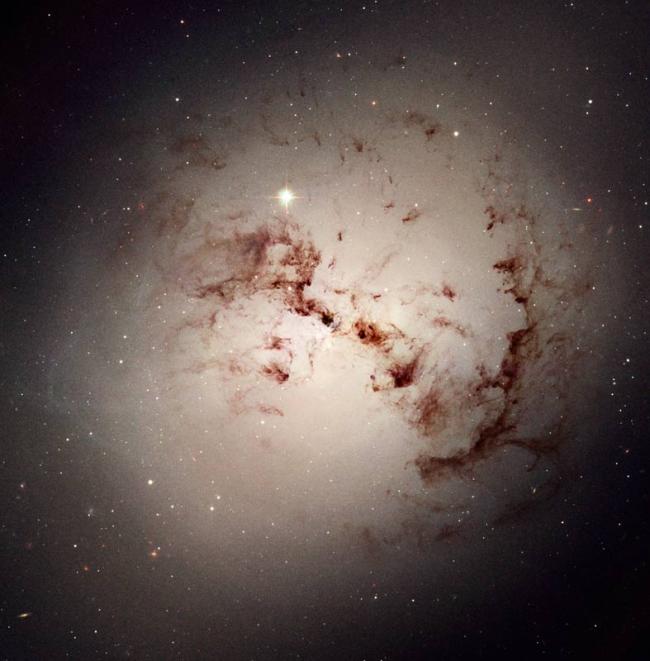
A Hubble Space Telescope image of NGC 1316.
Image Credit: NASA, ESA, and The Hubble Heritage Team (STScI/AURA)
... and for those of you that missed some of the important April 1st news, here are some highlights:
So as a word of warning, don't always believe everything you read - EVEN when it comes from a reputable source!28th March, 2005: From Galaxy Collisions to Star Birth
This week important clues on the triggering of star birth in colliding galaxies were unveiled. Data from ESA's Infrared Space Observatory (ISO) provided evidence of excited molecular hydrogen, which emits a distinctive signature at infrared wavelengths, in the overlapping regions of two colliding galaxies known as the "Antennae" (NGC 4038 and NGC 4039). This excited gas is observed during the pre-star birth phase of a region. The lack of associated supernova explosions in this area suggests that the gas was excited by shock waves generated by the collision of the galaxies and not by local supernovae. This is the first time this rare phase of star formation has been observed between colliding galaxies and these findings may improve our understanding of the formation of the first stars in the early Universe as proto-galaxies collided with one another.The future of the "Antennae" is bright, well at least in the infrared. The shock waves caused by the collision of the two galaxies will over the next few million years cause a flurry of star formation resulting in a two-fold increase in infrared brightness.

A Hubble Space Telescope image of the colliding galaxies NGC 4038 and NGC 4039 commonly known as the "Antennae". The overlayed dashed regions shows areas in which ESA's ISO has detected gas excited by shockwaves generated from the collision.
Image Credit: HST Image, ESA/NASA
21st March, 2005: Cassini Finds Atmosphere on Saturn's moon Enceladus
On March 9th the Cassini spacecraft swept past Saturn's icy moon Enceladus. The images Cassini recorded with its narrow-angle camera revealed a system of rifts, lanes of grooved terrain and a surface peppered with a relatively high density of cratering suggesting that this region of the surface is quite old.Intriguingly, Cassini's magnetometer, an instrument that detects the strength and direction of magnetic fields, discovered that Enceladus has a significant atmosphere. The magnetometer observed the bending of Saturn's magnetic field around the moon in a manner consistent with the Saturnian plasma being deflected from an extended atmosphere. The exact source of the atmosphere is not known but is thought to have resulted from volcanism, geysers or gases escaping from the surface or interior of the moon. It is believed that the atmosphere is mostly composed of ionized water vapour.
Cassini took this image of Saturn's moon Enceladus on March 9th with Saturn forming the backdrop.
Image Credit: NASA/JPL/Cornell
14th March, 2005: Spirit Rover Catches Martian Dust Devil
For quite sometime there has been indirect evidence of the existence of dust devils on Mars - these are like mini-tornados that stir dust up into the atmosphere. The trails they leave behind have been captured previously by the Mars Global Surveyor probe but they have not previously been directly imaged - until now! On its 421st sol, NASA's Mars Exploration Rover Spirit spotted two dust devils in action with its navigation camera.It is believed that dust devils are formed as warm air heated by the Sun rises in a whirling motion. It is also possible that they are formed by rotating columns of air that form as winds blow over craters on the Martian surface. Either way, they may have been beneficial to the Spirit rover. Just before the dust devil appeared Spirit's solar panels increased power output by 50 percent! This may have just been a co-incidence but it is also possible that the winds that caused the dust devil to form may have blown accumulated dust off the rover's solar panels.
Images taken by the Spirit rover on Mars showing the appearance of a Martian dust devil.
Image Credit: NASA/JPL/Cornell
7th March, 2005: The First Dark Galaxy Detected?
Try and spot the galaxy in the image below. Can't see it? Well neither could an international team of astronomers. Although the optical image does not reveal anything out of the ordinary radio data seems to paint a very different scene.Astrophysicist Dr. Virginia Kilborn of Swinburne University, along with an international team of researchers, discovered what appeared to be a large hydrogen gas cloud during a routine radio telescope survey of the hydrogen gas distribution in the Virgo cluster of galaxies. Subsequent measurements with the Arecibo radio telescope suggested that the gas is rotating in a manner similar to that of a spiral galaxy - yet to their surprise there were no stars to be found in the region. They had discovered what appeared to be a "dark" galaxy.
Although extraordinary if true, Dr. Kilborn warns that it is also possible that the hydrogen is not in fact isolated but rather the debris from a collision between galaxies. When galaxies collide or get close to each other they strip each other of stars and gas. The resulting pattern of gas could appear similar to that of a spiral galaxy. More data and analysis is needed before one can be more certain that this is in fact a "dark" galaxy - so stay tuned!
The extent of the suspected "dark" galaxy is shown by the ellipse.
Image Credit: Cardiff University
1st March, 2005: Welcome to SAO Semester 1, 2005
Welcome to SAO semester 1, 2005.
It's only been a few months since the end of the last semester and yet the pursuit for knowledge, understanding and discovery has continued unrelentlessly. Close to home SMART-1 has finally completed its 13 month journey to the moon, successfully demonstrating its solar-electric propulsion engine. NASA Mars rovers Spirit and Opportunity are still plodding along quite happily on the surface of Mars almost a year after their expected lifetime. Opportunity recently discovered a basketball-sized iron meteorite, the first of this type ever identified on a planet other than Earth. Meanwhile, Spirit has found further evidence that water once existed on Mars.
A bit further from home the Cassini spacecraft has been busily taking happy snaps of Saturn and its moons. High resolution images of Iapetus reveal a moon shaped like an enormous iced walnut while those of Mimas look eerily like the Death Star of Star Wars fame! Cassini also took this image of Saturn's Northern Hemisphere with its beautiful hues of blue.
Saturn's Northern hemisphere with Mimas in the foreground.
Image Credit: Cassini Imaging Team, SSI, JPL, ESA, NASA
Centre stage however was taken by the Huygens probe which was released from the Cassini spacecraft on Christmas eve. It reached its destination Titan on January 14th to reveal a stunning view of the Titanian landscape. Overall the mission was a great success, however, a missed command to the probe resulted in the loss of half of the images and the data from the Doppler wind experiment. Fortunately, radio telescopes around the world (including "The Dish" at Parkes , Australia) were able save the day and at least replace the Doppler experiment data.
A composite image taken on January 14th by the Huygens probe as it descended below the shroud of clouds that cover Titan. The image shows a surprisingly Earth-like landscape with shorelines, mountains and drainage channels. For more images see: ESA - Cassini-Huygens.
Image Credit: ESA, NASA, LPL
Moving out of the Solar System, a further 12 extrasolar planets have been discovered in the past month, bringing the total count to 145! The ESO VLT (Very Large Telescope) may have even, for the first time, directly imaged an extrasolar planet - as supported by further imaging with the Hubble Space Telescope.
Whilst NASA's Swift X-Ray Observatory has already pin-pointed more than a dozen gamma-ray bursts. It also observed the brightest ever flash of light ever recorded from beyond our Solar System. The flash lasted over a tenth of a second and originated from a giant magnetar (an exotic neutron star) flare about 50,000 light years from Earth. Not to be out done, NASA's Spitzer Space Telescope has been busy too, it recently imaged the well-known Ring Nebula (M57) to reveal its intricate outer shell.
NASA Spitzer Space Telescope image of the Ring Nebula
Image Credit: NASA/JPL-Caltech/J. Hora (Harvard-Smithsonian CfA)






